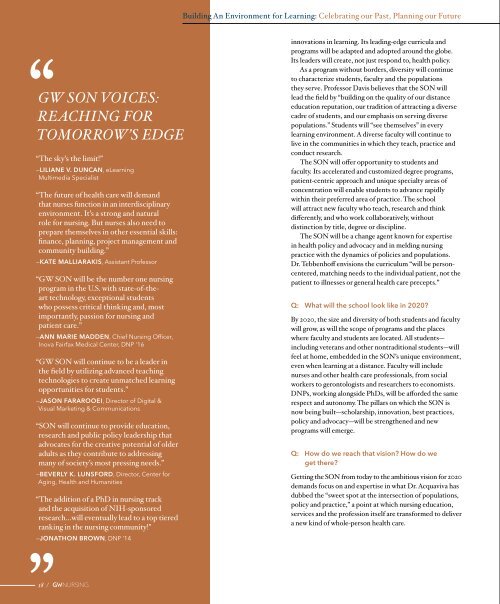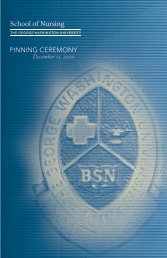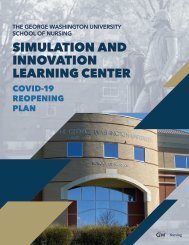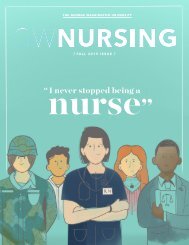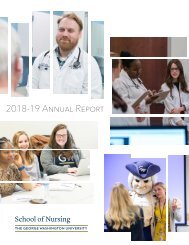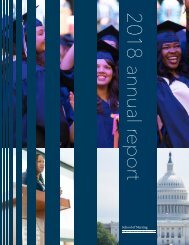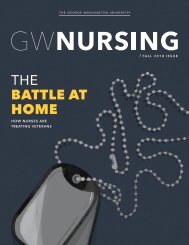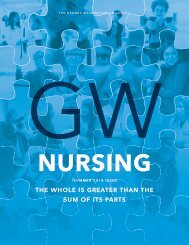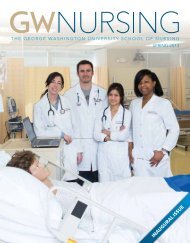GW Nursing Magazine Spring 2016
GW Nursing is a publication of the George Washington University School of Nursing. The magazine tells the story of GW nurses and their endeavors in the areas of education, research, policy and practice.
GW Nursing is a publication of the George Washington University School of Nursing. The magazine tells the story of GW nurses and their endeavors in the areas of education, research, policy and practice.
Create successful ePaper yourself
Turn your PDF publications into a flip-book with our unique Google optimized e-Paper software.
Building An Environment for Learning: Celebrating our Past, Planning our Future<br />
<strong>GW</strong> SON VOICES:<br />
REACHING FOR<br />
TOMORROW’S EDGE<br />
“The sky’s the limit!”<br />
—LILIANE V. DUNCAN, eLearning<br />
Multimedia Specialist<br />
“The future of health care will demand<br />
that nurses function in an interdisciplinary<br />
environment. It’s a strong and natural<br />
role for nursing. But nurses also need to<br />
prepare themselves in other essential skills:<br />
finance, planning, project management and<br />
community building.”<br />
—KATE MALLIARAKIS, Assistant Professor<br />
“<strong>GW</strong> SON will be the number one nursing<br />
program in the U.S. with state-of-theart<br />
technology, exceptional students<br />
who possess critical thinking and, most<br />
importantly, passion for nursing and<br />
patient care.”<br />
—ANN MARIE MADDEN, Chief <strong>Nursing</strong> Officer,<br />
Inova Fairfax Medical Center, DNP ‘16<br />
“<strong>GW</strong> SON will continue to be a leader in<br />
the field by utilizing advanced teaching<br />
technologies to create unmatched learning<br />
opportunities for students.”<br />
—JASON FARAROOEI, Director of Digital &<br />
Visual Marketing & Communications<br />
“SON will continue to provide education,<br />
research and public policy leadership that<br />
advocates for the creative potential of older<br />
adults as they contribute to addressing<br />
many of society’s most pressing needs.”<br />
—BEVERLY K. LUNSFORD, Director, Center for<br />
Aging, Health and Humanities<br />
“The addition of a PhD in nursing track<br />
and the acquisition of NIH-sponsored<br />
research…will eventually lead to a top tiered<br />
ranking in the nursing community!"<br />
—JONATHON BROWN, DNP ‘14<br />
innovations in learning. Its leading-edge curricula and<br />
programs will be adapted and adopted around the globe.<br />
Its leaders will create, not just respond to, health policy.<br />
As a program without borders, diversity will continue<br />
to characterize students, faculty and the populations<br />
they serve. Professor Davis believes that the SON will<br />
lead the field by “building on the quality of our distance<br />
education reputation, our tradition of attracting a diverse<br />
cadre of students, and our emphasis on serving diverse<br />
populations.” Students will “see themselves” in every<br />
learning environment. A diverse faculty will continue to<br />
live in the communities in which they teach, practice and<br />
conduct research.<br />
The SON will offer opportunity to students and<br />
faculty. Its accelerated and customized degree programs,<br />
patient-centric approach and unique specialty areas of<br />
concentration will enable students to advance rapidly<br />
within their preferred area of practice. The school<br />
will attract new faculty who teach, research and think<br />
differently, and who work collaboratively, without<br />
distinction by title, degree or discipline.<br />
The SON will be a change agent known for expertise<br />
in health policy and advocacy and in melding nursing<br />
practice with the dynamics of policies and populations.<br />
Dr. Tebbenhoff envisions the curriculum “will be personcentered,<br />
matching needs to the individual patient, not the<br />
patient to illnesses or general health care precepts.”<br />
Q: What will the school look like in 2020?<br />
By 2020, the size and diversity of both students and faculty<br />
will grow, as will the scope of programs and the places<br />
where faculty and students are located. All students—<br />
including veterans and other nontraditional students—will<br />
feel at home, embedded in the SON’s unique environment,<br />
even when learning at a distance. Faculty will include<br />
nurses and other health care professionals, from social<br />
workers to gerontologists and researchers to economists.<br />
DNPs, working alongside PhDs, will be afforded the same<br />
respect and autonomy. The pillars on which the SON is<br />
now being built—scholarship, innovation, best practices,<br />
policy and advocacy—will be strengthened and new<br />
programs will emerge.<br />
Q: How do we reach that vision? How do we<br />
get there?<br />
Getting the SON from today to the ambitious vision for 2020<br />
demands focus on and expertise in what Dr. Acquaviva has<br />
dubbed the “sweet spot at the intersection of populations,<br />
policy and practice,” a point at which nursing education,<br />
services and the profession itself are transformed to deliver<br />
a new kind of whole-person health care.<br />
18 /


